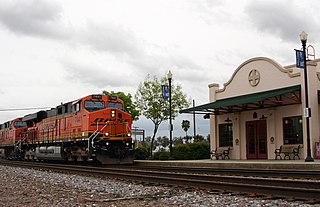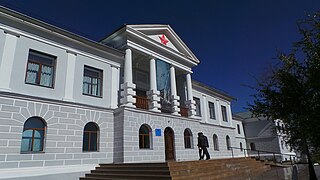
Corcoran is a city in Kings County, California, United States. The population was 24,813, up from 14,458. Corcoran is located 17 miles (27 km) south-southeast of Hanford, at an elevation of 207 ft (63 m).

The Kempeitai was the military police of the Imperial Japanese Army. The organization also shared civilian secret police, espionage, and counter-intelligence roles within Japan and its occupied territories, and was notorious for its brutality and role in suppressing dissent. The broad duties of the Kempeitai included maintaining military discipline, enforcing conscription laws, protecting vital military zones, and investigating crimes among soldiers. In occupied areas, it also issued travel permits, recruited labor, arrested resistance, requisitioned food and supplies, spread propaganda, and suppressed anti-Japanese sentiment. At its peak at the end of World War II, the Kempeitai was an extensive corps with about 35,000 personnel.

Monowitz was a Nazi concentration camp and labor camp (Arbeitslager) run by Nazi Germany in occupied Poland from 1942–1945, during World War II and the Holocaust. For most of its existence, Monowitz was a subcamp of the Auschwitz concentration camp; from November 1943 it and other Nazi subcamps in the area were jointly known as "Auschwitz III-subcamps". In November 1944 the Germans renamed it Monowitz concentration camp, after the village of Monowice where it was built, in the annexed portion of Poland. SS Hauptsturmführer (Captain) Heinrich Schwarz was commandant from November 1943 to January 1945.
California's 22nd congressional district is a congressional district in the U.S. state of California. It is represented by David Valadao, who formerly represented California's 21st congressional district from 2013 to 2019 and 2021 to 2023. As of 2024, this district, alongside New York's 4th, is the most Democratic-leaning congressional district represented by a Republican, with a partisan lean of D+5. It was also one of 18 districts that would have voted for Joe Biden in the 2020 presidential election had they existed in their current configuration while being won or held by a Republican in 2022.

By the end of World War II, the number of Romanian prisoners of war in the Soviet Union was significant. Up to 100,000 Romanian soldiers were disarmed and taken prisoner by the Red Army after the Royal coup d'état of August 23, 1944, when Romania switched its alliance from the Axis Powers to the Allies. Before that date, almost 165,000 Romanian soldiers were reported missing, with most of them assumed to be POWs. Soviet authorities generally used prisoners of war as a work force in various labor camps.

Camp Tulelake was a federal work facility and War Relocation Authority isolation center located in Siskiyou County, five miles west of Tulelake, California. It was established by the United States government in 1935 during the Great Depression for vocational training and work relief for young men, in a program known as the Civilian Conservation Corps. The camp was established initially for CCC enrollees to work on the Klamath Reclamation Project.

The Blechhammer area was the location of Greater German Reich chemical plants, prisoner of war camps, and forced labor camps. Labor camp prisoners began arriving as early as June 17, 1942, and in July 1944, 400–500 men were transferred from the Terezin family camp to Blechhammer. The mobile "pocket furnace" crematorium was at Sławięcice.) and Bau und Arbeits Battalion 21 was a mile from the Blechhammer oil plants and was not far from Kattowitz and Breslau. Blechhammer synthetic oil production began April 1, 1944 with 4000 prisoners, with the slave labor camp holding these prisoners during April 1944, becoming a satellite camp of the dreaded Auschwitz extermination camp, as Arbeitslager Blechhammer.

Arvin Federal Government Camp, also known as the Weedpatch Camp or Sunset Labor Camp, was built by the Farm Security Administration south of Bakersfield, California, in 1936 to house migrant workers during the Great Depression. The National Register of Historic Places placed several of its historic buildings on the registry on January 22, 1996.

In the years following World War II, large numbers of German civilians and captured soldiers were forced into labor by the Allied forces. The topic of using Germans as forced labor for reparations was first broached at the Tehran conference in 1943, where Soviet premier Joseph Stalin demanded 4,000,000 German workers.
Camp Rupert was a World War II prisoner of war camp in the western United States, located in Minidoka County, Idaho, west of Paul. It was built for $1.5 million, which was everything needed for a city of 3,000: barracks, water, sewer, and a hospital. The first POWs were Italian and were received in May 1944, and 500 German POWs arrived that September.

Rough and Ready Island Naval Supply Depot or Ruff and Ready Island is a former United States Navy installation on the San Joaquin River in Stockton, California in San Joaquin County, near the Stockton Channel and was 3 miles (4.8 km) west of Stockton. The Supply Depot was built during World War II as part of the San Joaquin Depot that operated the nearby Tracy Depot Facility and the Sharpe Depot Facility. It was named in honor of President Zachary Taylor.

Members of the German military were interned as prisoners of war in the United States during World War I and World War II. In all, 425,000 German prisoners lived in 700 camps throughout the United States during World War II.

The Temporary Detention Camp for Japanese Americans / Pomona Assembly Center is one of the places Japanese Americans were held during World War II. The Pomona Assembly Center was designated a California Historic Landmark on May 13, 1980. The Pomona Assembly Center is located in what is now called the Fairplex in Pomona, California in Los Angeles County. The Pomona Assembly Center was called Los Angeles County Fairgrounds in 1942.

California during World War II was a major contributor to the World War II effort. California's long Pacific Ocean coastline provided the support needed for the Pacific War. California also supported the war in Europe. After the Japanese attack on Pearl Harbor on December 7, 1941, most of California's manufacturing was shifted to the war effort. California became a major ship builder and aircraft manufacturer. Existing military installations were enlarged and many new ones were built. California trained many of the troops before their oversea deployment. Over 800,000 Californians served in the United States Armed Forces. California agriculture, ranches and farms were used to feed the troops around the world. California's long coastline also put the state in fear, as an attack on California seemed likely. California was used for the temporary and permanent internment camps for Japanese Americans. The population grew significantly, largely due to servicemen who were stationed at the new military bases/training facilities and the mass influx of workers from around the U.S. in the growing defense industries. With all the new economy activity, California was lifted out of the Great Depression. Over 500,000 people moved to California from other states to work in the growing economy. California expanded its oil and mineral production to keep up with the war demand.

Camp Haan was a US Army training camp built in 1940, near March Air Force Base in Riverside County, California Camp Haan was opened in January 1941 as a training camp for Coast Artillery Antiaircraft gunners. The 8,058 acres camp was about four miles by three miles with tent housing. The camp was named after Major General William George Haan of World War I. By the end of 1941, the camp had a wood service building, 28 miles of streets, five chapels, and a hospital. The first troops trained were sent for the defense of Los Angeles and San Francisco. The Attack on Pearl Harbor and the Battle of Los Angeles–Bombardment of Ellwood had put all of California on high alert. The Army Service Depot was added to the camp in March 1942. The site of the former Camp Haan is next to California Interstate 215 at the Van Buren Boulevard exit.
DeWitt General Hospital was a World War II US Army Hospital in Auburn, California, in Placer County at the corner of C Avenue and First Street. The hospital was built in 1944 to care for troops returning home from overseas service and troops that served on the home front. The first patient checked in on February 17, 1944. The hospital had 2,285 beds housed in single story buildings over the 284 acres campus. DeWitt General Hospital was three miles north of downtown Auburn.

Helm Field also called Lemoore Auxiliary Army Airfield A-7 is a former US Army Airfield use for training during World War II. Helm Field was location in the town of Coalinga, California, 70 miles south of Fresno. Helm Field had two 3,000 foot runways, one oriented east/west and one oriented northwest/southeast. The Airfield was on a 773 acres site of form farm land. The US Army purchased the land on January 11, 1943 for training pilots. The Airfield was used by the Lemoore Basic Flying School, based at the Lemoore Army Air Field. Helm Field was 15 miles northwest of Lemoore Army Air Field. The Army built at Helm Field to support training stage house, control tower, motor pool building, crash truck shelter and latrines. Helm Field was used by Air Corps Basic Flying School, the AAF Basic Flying School, the AAF Pilot School, the 88th Air Base Squadron, the 3023rd Army Air Force Pilot School and the 461st Army Air Force Base Unit. The army closed Helm Field on October 15, 1844 and the Airfield was sold by the War Assets Administration. Helm Field was used as a farm labor camp in the 1950s. The east/west runway was returned to farmland. The northwest/southeast runway was still intact and was used as a civilian airfield till 1971.

Gardner Army Airfield auxiliary fields were a number of airfields used during World War II to support the Gardner Army Airfield. May 12, 1943 the US Army leased 1,396.36 acres for Gardner Field, located 9 miles southeast of Taft, California. Gardner Army Airfield was named after Major John H. Gardner, a World War I aviator hero. The Army built three runways to support training activities need for World War II. From Gardner Army Airfield the United States Army Air Corps's Western Flying Training Command started training the needed pilots. To support the training of the many pilots, Gardner Army Airfield operated a number of auxiliary airfields. Some auxiliary fields were no more than a landing strip, others were other operation airfield that supported the training at the Gardner Army Airfield. The Vultee BT-13 Valiant and Boeing-Stearman Model 75 were the most common planes used for training at Gardner Army Airfields, but large bombers were trained also. Gardner Army Airfield auxiliary fields were:
The Italian Service Units or ISUs were military units composed of Italian prisoners of war (POWs) that served with the Allies during World War II against Nazi Germany and the Empire of Japan from May 1944 to October 1945. The armed forces of the United States captured many Italian soldiers during the North African campaign Operation Torch, which started in November 1942 and sent 51,000 of them to the United States. After the signing of the armistice by the Badoglio government in Italy on September 8, 1943, and with Pietro Badoglio and the Kingdom of the South officially declaring war on Nazi Germany on October 13, 1943, the Americans began to see the POWs as potential allies. The capture of Rome by the Allies on June 4, 1944, motivated many POWs to change sides. About 90% joined Italian Service Units, which operated in the United States and overseas.















